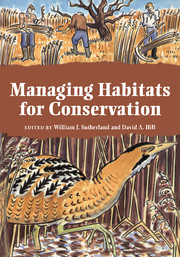Book contents
- Frontmatter
- Contents
- List of Contributors
- Acknowledgements
- 1 Introduction and principles of ecological management
- 2 Site management planning
- 3 Access
- 4 Coastal habitats
- 5 Rivers, canals and dykes
- 6 Waterbodies
- 7 Reedbeds, fens and acid bogs
- 8 Grasslands
- 9 Farmland
- 10 Lowland heathland
- 11 Upland moors and heaths
- 12 Woodland and scrub
- 13 Urban areas
- Some useful addresses
- Index of species by common names
- Subject index
11 - Upland moors and heaths
Published online by Cambridge University Press: 05 February 2015
- Frontmatter
- Contents
- List of Contributors
- Acknowledgements
- 1 Introduction and principles of ecological management
- 2 Site management planning
- 3 Access
- 4 Coastal habitats
- 5 Rivers, canals and dykes
- 6 Waterbodies
- 7 Reedbeds, fens and acid bogs
- 8 Grasslands
- 9 Farmland
- 10 Lowland heathland
- 11 Upland moors and heaths
- 12 Woodland and scrub
- 13 Urban areas
- Some useful addresses
- Index of species by common names
- Subject index
Summary
Introduction
This is a chapter about myths and magic. The myth is that the uplands of Britain are well managed and self-perpetuating with a beauty and wildlife fashioned by the kinder elements of nature and humans! The magic is that in just a few regions – amongst some of the hills and on just a few estates – there are heaths and bogs, woodlands and grasslands, abounding in plants and animals that bring the meaning of ‘sustainable biodiversity’ alive. For the good keeper of an estate, manager of a National Nature Reserve or the inspired visitor the distinction is strikingly obvious. How then do we spread this magic across the uplands?
The uplands are defined here as the third of Britain's land surface lying above the upper reaches of enclosed farmland (Ratcliffe & Thompson, 1988). They may appear to be the product of millennia of deforestation and wilful burning which has produced a distinctively open, apparently stunted range of habitats managed principally for forestry, sheep, Red Grouse Lagopus lagopus and Red Deer Cervus elaphus. But, they still retain much of natural interest and conservation value, and a sense of wildness not found elsewhere.
As a land manager one has to ask four questions:
What am I to manage the land for?
How do I achieve these goals?
Where do I begin?
Over what timescale should I measure my success?
- Type
- Chapter
- Information
- Managing Habitats for Conservation , pp. 292 - 326Publisher: Cambridge University PressPrint publication year: 1995
- 6
- Cited by



